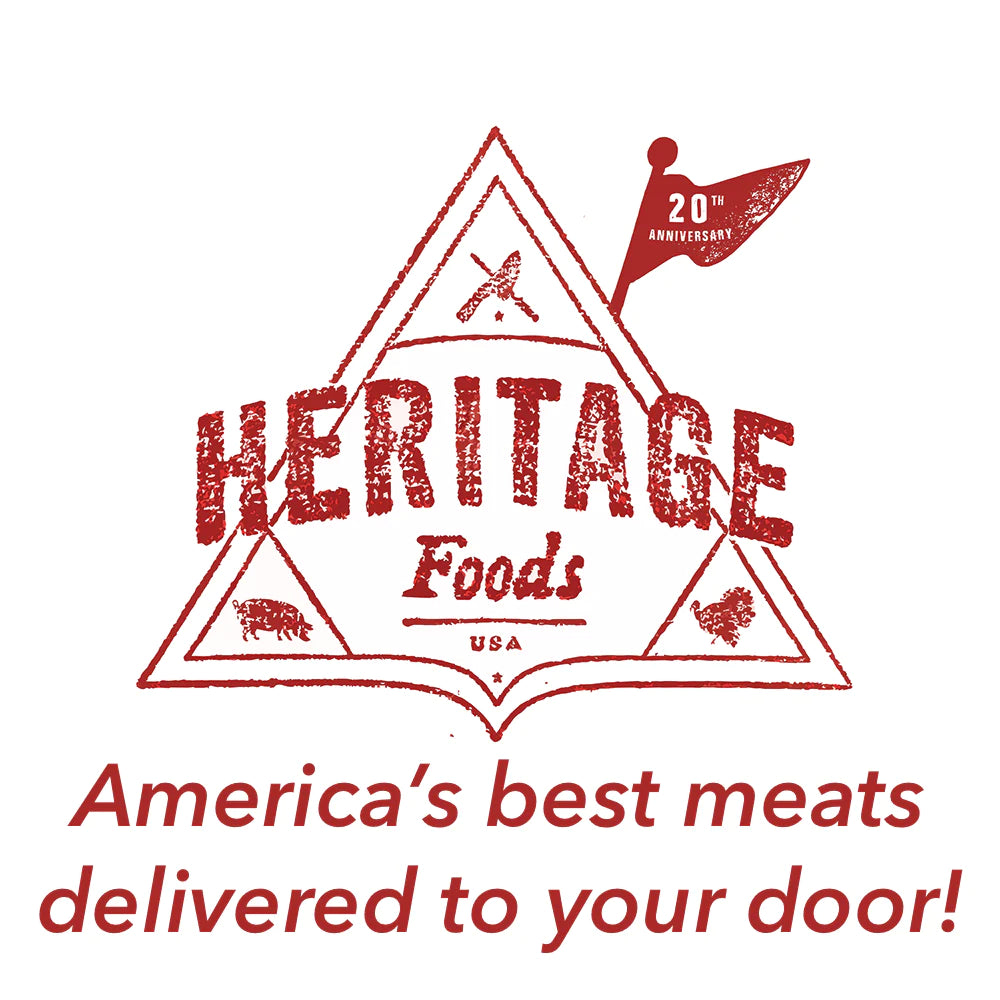100% Customer Satisfaction Guaranteed | Questions? Call Us at (718) 389-0985
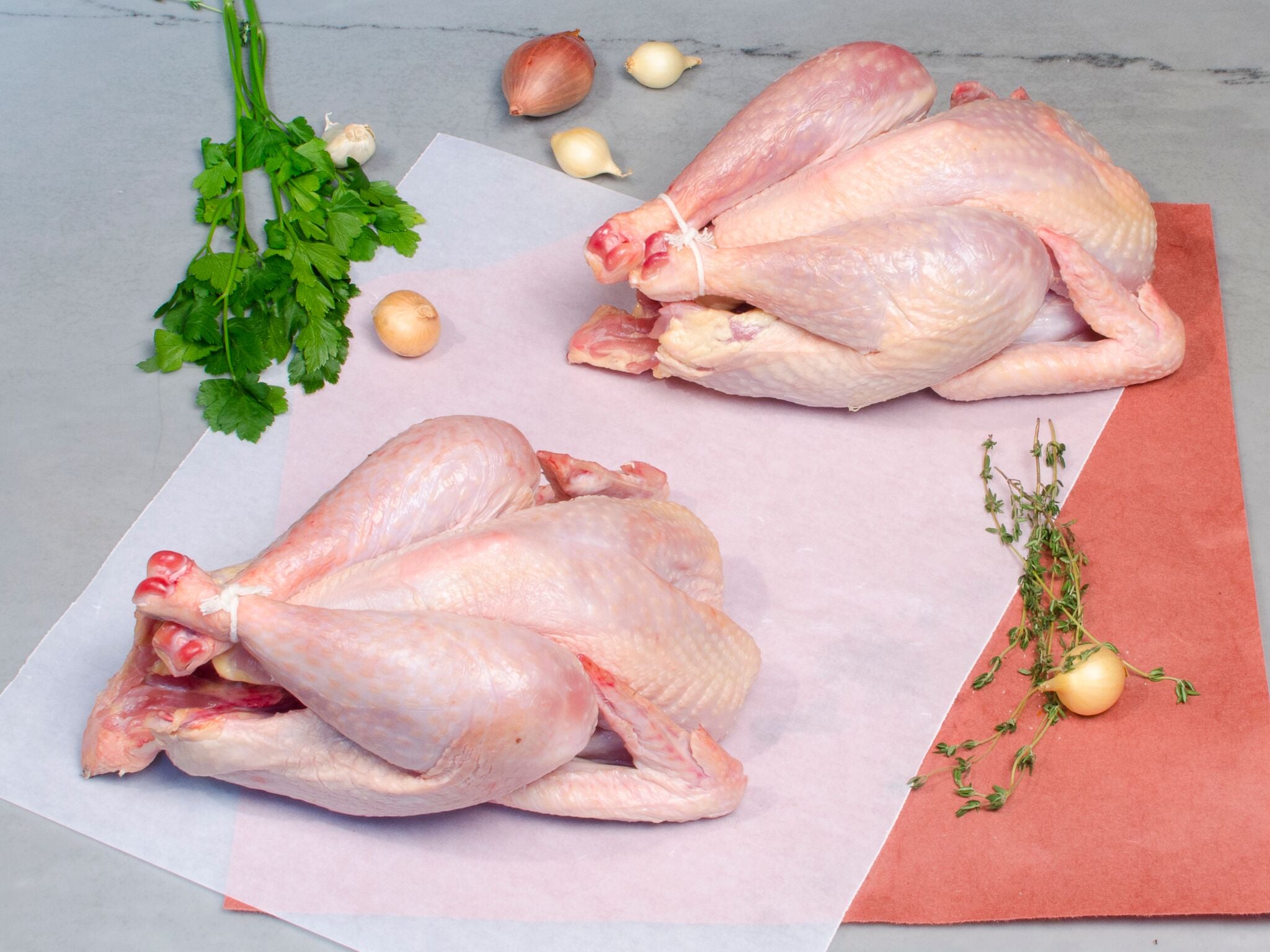
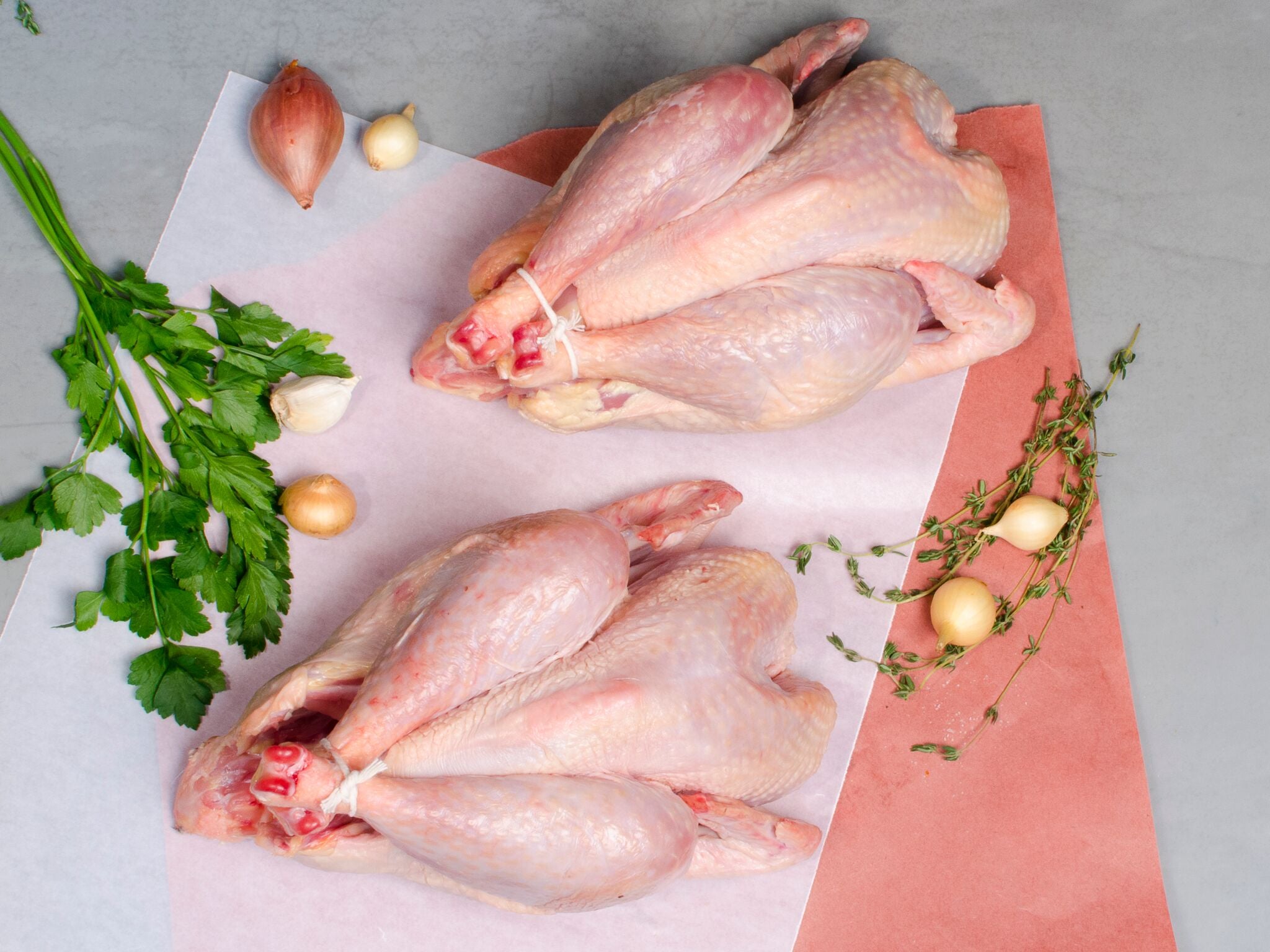

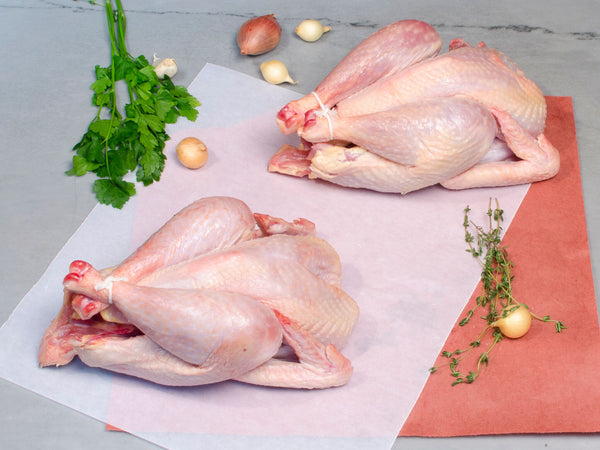
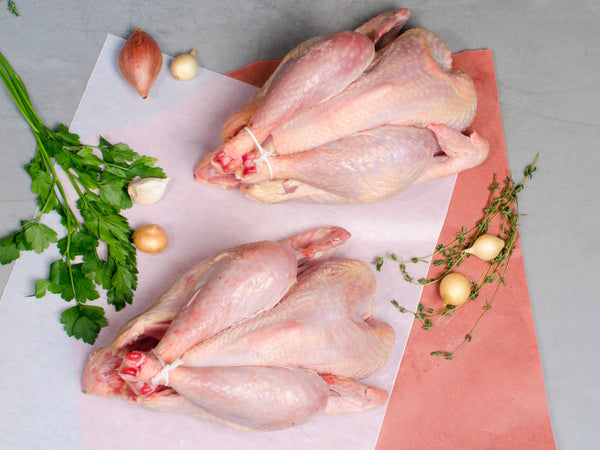
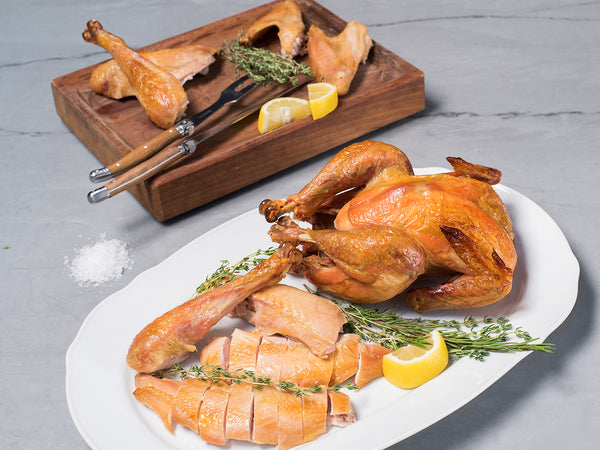



Two whole chickens, one each from New Hampshire and Delaware breeds
Whole Chicken 2 Breed Tasting Kit
Two 3-4lb birds, packaged individually
One each from New Hampshire and Delaware
Certified Standardbred, Pasture Raised, Free Ranging Flock, Vegetarian Fed, Naturally Mating, and Antibiotic Free from hatching to plate.
This is a groundbreaking development for the heritage meat movement and the cause of biodiversity in food because our collaboration works towards preserving (and eating!) poultry that are on the brink of extinction.
Standardbred chickens are slow-growing and pasture raised to 16 weeks, more than double the industry standard. Each chicken is laced with ribbons of sun-yellow fat that self-baste the bird as it renders, resulting in silky meat and crackly bronzed skin.
Kansas-based heritage farmer Frank Reese, who has made it his life’s work to preserve endangered breeds of poultry, has worked for years to maintain stronger lines of chickens. Reese has partnered with his first-ever protégé, Jed Greenberg of Chosen Farms, to raise and process kosher and non-kosher chickens in New Jersey.
Good Shepherd chickens can be traced back over 100 years, are 100% antibiotic free, and are pasture raised. This is by far the juiciest, most flavorful bird on the market today.
Tamar Adler, in Vogue magazine, writes, "And the flavors! I am stunned by the Plymouth Rock, which smells like hay and has a marigold-yellow, pork-style fat cap beneath its skin. Its flesh is silky and grassy, bringing to mind smoked sablefish. The New Hampshire has meat that is almost lavender and tastes closer to an oyster, or perhaps Lardo di Colonnata cured in ancient marble, than to any chicken I’ve ever eaten. It’s rich in umami, that indescribable flavor in soy sauce, Parmesan cheese, truffles, and aged meat."
Good Shepherd Poultry Ranch is one of the most important farms in the world. Every morning at sunrise, for more than 50 years — in rain, snow, deep cold and heat — Frank Reese opens the massive doors of the huge barns that house his few thousand birds, starting a trickle, then a wave, of chickens and turkeys who will free range the hundred-acre property for the day, before they are shepherded back indoors at night. These birds are truly free range and spend their time walking, picking the fields for food, naturally reproducing, and flying onto trees and fence tops. And they are truly from old stock — on this farm in Kansas live some of the last chickens and turkeys from a time before factory farming took over our food system. They are all endangered breeds.
Right before our eyes, dozens of our foundational poultry breeds are on the brink of extinction. These strains’ importance to America’s culture, food safety, and biodiversity is incalculable. Their loss would spell disaster for the future of the sustainable food system.
While most remain unaware of the looming extinction of Standardbred poultry breeds in the United States, there is a small community working to combat this crisis. One man on the plains of the Kansas prairie stands out as their greatest champion. Frank, in his seventies, is the sole remaining commercial breeder of Certified Standardbred poultry in the United States.
His Good Shepherd Poultry Ranch stands as the last remaining stronghold for many of America’s most important market breeds of chickens and turkeys with lineages dating back to the 19th and early 20th century including Plymouth Rock, New Hampshire, Rhode Island White, Cornish, Leghorn, Minorca, Bronze, Narragansett, White Holland and Bourbon Red.
Having only one commercial farm left in the country to protect these natural treasures leaves them extremely vulnerable. In order to provide a safe future for these breeds, we must drastically increase their numbers. To address this issue, Frank Reese has started a nationwide conservation effort which will increase 10 breeds’ numbers to 100,000+ birds and spread them out over hundreds of farms throughout the United States. Heritage Foods, together with the Good Shepherd Conservancy, a 501(c)(3) non-profit, are building a center to train farmers, to grow a larger hatchery to produce more birds, and to bring visitors from around the world to learn about this important issue.
The agri-tourism site being built on the farm will allow consumers, chefs, and farmers to visit for themselves the world site that is Good Shepherd Ranch. There is a collage of multicolored feathers on Franks farms, from birds that each boast a unique history, taste, and flavor. The Bronze turkey for example shimmers with its coppery, bronze-colored metallic sheen and has origins in Rhode Island —it is the foundation for all domestic turkeys in the United States and the closest connection we have to the origin of the domesticated turkey.
The Barred Rock chicken, with its beautiful white and black barred feather pattern, is the foundation of the chicken industry and was raised by the millions from 1870 -1950. They remained king of the industry until they were replaced by the industrial Cornish. They say the original Barred Rock has never been beat in a tasting contest. As an animal it is hearty, tough and reliable as well as lovely to look at.
It’s remarkable to think that almost every bird in the United States comes from the same genetic stock, derived from the same two or three industrial hatcheries producing unhealthy birds that cannot fly or survive in nature, and that have been built to die after only two or three years. The baby poults being supplied to farms large and small are a far cry from their healthy ancestors. They have not been genetically modified, like seed companies do, but they have been so overbred for certain traits like large breast size, fast growth, and small legs that they must be fed antibiotics and kept indoors to survive. The technology does not exist to freeze poultry sperm, so rare breeds must continue to reproduce their flocks on the farm, generation to generation, making Frank’s place in the world all the more important.
When Heritage Foods first started we sold only heritage turkeys from Good Shepherd Poultry Ranch. We learned about them through the Slow Food Ark of Taste Project designed to save foods on the brink of extinction. The story of Frank was so compelling to us — his birds came to him from his mentor Norman Kardosh who inherited the birds from his Mother who had received heritage eggs by train from the Bird Brothers Hatchery in the 1860s. The birds Frank raises are essentially descended from stock that have only ever lived on the same two farms for more than 100 years! When we came to understand all these details, and that Frank was the last of his kind, just like so many of the birds on his farm — we had to do something!
Through sales direct to homes and to restaurant chefs, markets, and butchers we have managed to lay a stake in the ground claiming that we will not lose these birds to history and that fast food will not overtake our entire food supply! Thank you to all the buyers who have made this conservation effort a success story, all the while enjoying by far the tastiest birds on the market today!
Plymouth Rock
The Plymouth Rock, America’s first officially recognized breed of chicken, reigned as king of the United States’ broiler industry for over 100 years. Its reliability, adaptability, health, and quality kept it immensely popular until the rise of the Cornish cross hybrid in the mid-1900s.
While today, millions of striped birds in the United States are sold each year bearing the name of this iconic breed, true Plymouth Rocks are few and far between. This storied past and the many important traits the Plymouth Rock holds all make it crucially important to the future of Standardbred broiler production in the United States.
New Hampshire
The New Hampshire is a beautifully red-feathered and fast-growing breed that epitomizes American innovation and quality. Prized for its rapid early growth, heavier breast development, and solid egg-laying ability, this newer breed was able to dethrone the Plymouth Rock as America’s #1 chicken in the 1930s.
The many important traits that made the New Hampshire popular in the past still make it a highly marketable and critically important Standardbred specimen. While today, many industrial hybrids such as the “Red Ranger” are regularly confused with the New Hampshire, true quality stock from this breed is very hard to find.
Cornish
The Cornish is probably the most misunderstood and endangered of all the important breeds in the United States. Its true history is lost in time, but it is given credit for development in Cornwall, England.
Originally a fighting bird, its short, bulldog-like body eventually became prized for its meatiness, superior breast size, and flavor. While the modern-day “Cornish cross hybrid” and the so-called “Cornish game hen” (just a young Cornish cross) have some genes derived from the Cornish, they could not be more different from their partial ancestor.
The Cornish is a very slow-growing bird and a poor egg layer, which is not marketable in itself, but when crossed with other Standardbred birds, it helps to greatly improve the carcass quality and breast size of the resulting offspring. These crosses are healthy and highly marketable heritage birds, which can better compete against the industrially produced “Cornish cross” and “Freedom Ranger” F14 hybrids that dominate today’s broiler market.
Delaware
Delawares, originally called “Indian Rivers,” were developed by George Ellis of Delaware in 1940 and were used for the production of broiler chickens. The breed originated from crosses of Barred Plymouth Rock roosters and New Hampshire hens. A few off-colored sports were produced that were almost white with black barring on the hackles, primaries, secondaries, and tail. This coloration is similar to the Colombian color pattern, but with the barring substituting for the black sections.
For about twenty years, the Delaware and the Delaware x New Hampshire cross were the most popular broiler chickens on the Delmarva Peninsula because of the breed’s ability to produce offspring with predominately white feathering. This is an advantage for carcass appearance since white feathers don’t leave dark spots on the skin when they grow in. Both the Delaware and the Delaware x New Hampshire were replaced in the late 1950s by the Cornish x Rock cross (solid white) that now dominates the industry. — The Livestock Conservancy
How to Prepare
1. Take the bird out of the refrigerator an hour prior to cooking.
2. Rub with olive oil or butter, season with salt, pepper, and your favorite herbs like rosemary and thyme. Roast in the middle of a 325°F oven.
3. Cook to an internal temperature of 155°F, remembering that the temperature will continue to rise after leaving the oven.
Calculate about 10 minutes per pound depending on the size of the bird in a 325°F oven.
© 2024, Heritage Foods Powered by Shopify
